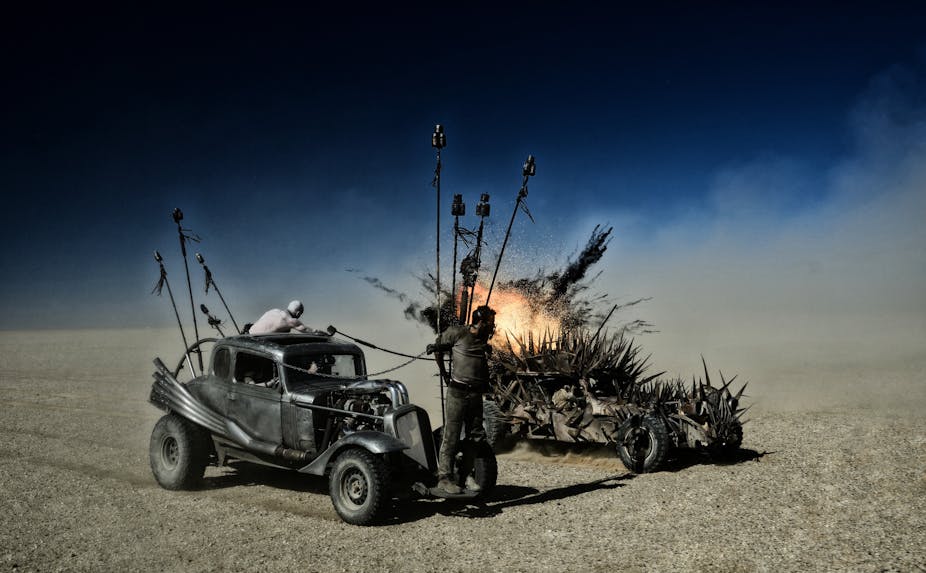What if Mad Max were Jewish? So asks Neil Pollack in American Jewish magazine The Forward. Certainly, on the surface, there is probably nothing more obviously gentile than a film set in post-apocalyptic Australia, featuring a series of war-mongers in souped-up cars, jeeps, trucks, rigs, motorbikes and so on, and in which no one ever seems to eat.
The endless deserts and salt flats evoke no land overflowing with milk and honey. But probe a little deeper and a subsurface Jewish ethos can be found in Mad Max: Fury Road.
First, there is the name of our protagonist, Max Rockatansky. Both his given and family names suggest an eastern or central European Jewish heritage.
Second, Max is a nomad. A survivor. Homeless, he evokes the Wandering Jew.
Third, and most significantly, as Nick Pinkerton points out in Sight & Sound:
Miller is making an epic, and has chosen his visual references accordingly: Joe’s ‘Citadel’ reproduces the high and low strata of Lang’s Metropolis (1927), while the flight across the desert, replete with a sandstorm whipped up by a freak cyclone, evokes the Old Testament shock and awe that evaded Ridley Scott’s Exodus: Gods and Kings.
Exodus
Max is initially imprisoned in the Citadel run by a warlord name Joe who has constructed a cult of personality around himself that reveres him as a godlike saviour. Meanwhile he has enslaved the local inhabitants by restricting their access to water. Just like any dictator, or Pharaoh, he also has a personal harem.
While incarcerated, Max’s back is tattooed in a manner reminiscent of the Jewish author Franz Kafka’s bodily-inscription-as-execution as recounted in his short story In the Penal Colony. Of course, the tattoo also suggests the numbers on the arms of Holocaust survivors.
Like Moses, Max is a reluctant hero. Also similar to Moses, he is a man of few words. In Exodus 4:10, Moses initially resists being God’s messenger, saying:
Please, O Lord, I have never been a man of words … I am heavy of mouth and heavy of tongue.
Max is haunted by visions of a child just as Moses (Christian Bale) is in Exodus: Gods and Kings. But Max does not encounter a burning bush so much as burning gasoline and flame throwers.
Max escapes from captivity when warlord Joe seeks to recapture his harem whom Furiosa (Charlize Theron) has smuggled out of the Citadel. In this, Furiosa resembles other Jewish heroines, principally Queen Esther who intervenes to save her people from potential genocide. Furiosa can also be seen as a combination of Yael from the Book of Judges who kills the general Sisera with a mallet and tent peg, or Judith who decapitates another general, Holofernes.

Joe sends his post-apocalyptic equivalent of Pharaoh’s chariots to recover his harem and to bring back Furiosa. Although the women eventually find freedom, Max leads them back to the “promised land”, that is, an unguarded Citadel which, if they can make it back alive, is theirs for the taking. When they do, images of the heroic Max among the starving and thirsty slaves evoke those of the biblical Exodus.
Ghosts of the Holocaust
Mad Max was shot in the Namib Desert of south-west Africa. This is also where the footage for the front projection in the The Dawn of Man sequence in 2001: A Space Odyssey (1968) was filmed. Directed by Stanley Kubrick, this sequence also has biblical resonances, invoking the Garden of Eden and the story of Cain and Abel.
This Namibian landscape also bears the traces of the Holocaust. Under German colonial administration it is where Germany rehearsed for what would turn out to be the Final Solution, carrying out a genocide on the native populations. And if Mad Max resembles Metropolis, then this too invokes the Holocaust – for in that film one can see the harbingers of Nazism.
So perhaps it is not such a stretch to imagine that Mad Max is Jewish after all.

